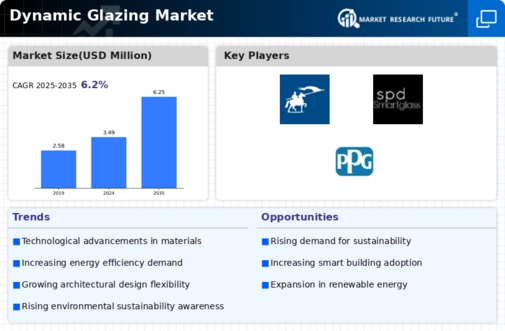Market Trends
Key Emerging Trends in the Dynamic Glazing Market
The dynamic glazing market has been experiencing significant trends driven by advancements in building technologies, increasing emphasis on energy efficiency, and sustainability initiatives. Dynamic glazing, also known as smart or switchable glass, refers to glass panels that can change their properties in response to external stimuli such as light, heat, or electricity. One prominent trend in the dynamic glazing market is the growing demand for energy-efficient building solutions. With rising energy costs and growing concerns about environmental sustainability, building owners and developers are increasingly turning to dynamic glazing systems to reduce energy consumption and improve building performance. These systems can dynamically adjust their tint or transparency to optimize natural light, solar heat gain, and glare, thereby reducing the need for artificial lighting, heating, and cooling, and enhancing overall energy efficiency.
The technology permits a thin coating to change from totally clear to tinted after applying a small DC voltage. The most generic example of this technology is the eyeglasses which darken once you go outside. The architectural example of dynamic glass can be maintained in four different tint levels, matching 4%, 20%, 40%, and 60% visible light transmission, respectively. A reduced carbon footprint is promoted by innovative architectural glazing solutions, which help achieve LEED certification and decrease energy costs.
Moreover, technological advancements are driving innovation in the dynamic glazing market, leading to the development of advanced smart glass technologies with improved performance and functionality. Manufacturers are investing in research and development efforts to enhance the optical and mechanical properties of dynamic glazing systems, including faster response times, wider range of tinting options, and better durability. Additionally, advancements in sensor technology, automation, and connectivity enable dynamic glazing systems to be integrated into building management systems, allowing for real-time monitoring and control of light and heat transmission based on environmental conditions and occupant preferences.
Furthermore, the dynamic glazing market is witnessing growth due to increasing adoption in various end-use sectors, including commercial buildings, residential buildings, automotive, and aerospace. In the commercial sector, dynamic glazing systems are being increasingly used in office buildings, hotels, and retail spaces to enhance occupant comfort, reduce energy costs, and create visually appealing and sustainable environments. In the residential sector, dynamic glazing is gaining popularity in high-end homes and green building projects as homeowners seek energy-efficient and technologically advanced solutions for their windows and facades. Additionally, dynamic glazing is finding applications in automotive and aerospace industries for windows, sunroofs, and cockpit canopies, offering improved visibility, comfort, and safety.
However, the dynamic glazing market also faces challenges such as high initial costs, complex installation requirements, and regulatory constraints. The initial costs associated with dynamic glazing systems, including the cost of materials, installation, and integration with building management systems, can be relatively high compared to traditional glazing solutions. Additionally, the complexity of installation and integration processes, as well as the need for specialized skills and equipment, can pose challenges for architects, engineers, and contractors. Moreover, regulatory constraints related to building codes, safety standards, and environmental regulations may influence the adoption and implementation of dynamic glazing systems in certain regions.






Leave a Comment